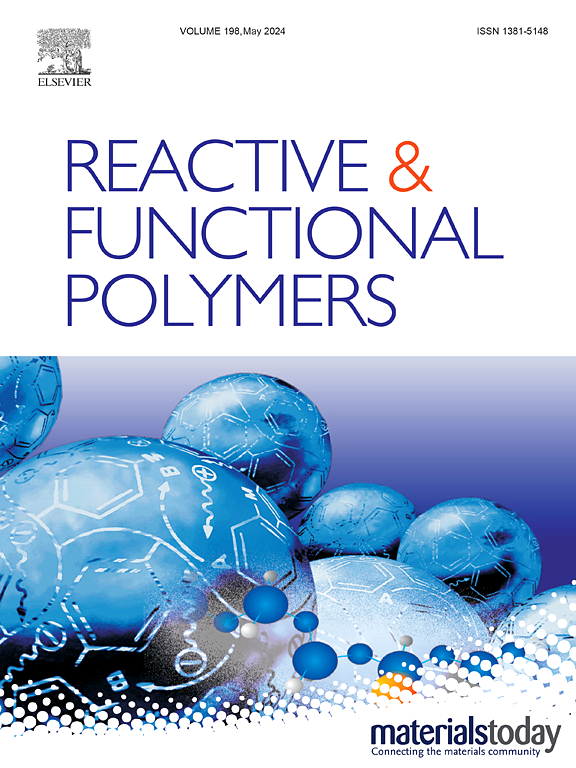In vitro antibacterial activity and cytotoxicity of Thermo-sensitive composite hydrogels with encapsulated CuFe-LDH
IF 5.1
3区 工程技术
Q1 CHEMISTRY, APPLIED
引用次数: 0
Abstract
Copper‑iron layered double hydroxides (CuFe-LDHs) with varying Cu/Fe atomic ratios and intercalated CO32−/HCO3− anions were successfully synthesized via a solvothermal method. The as-prepared CuFe-LDHs exhibited a sheet-like morpHology, with particle size increasing as the Cu/Fe ratio increased. Their antibacterial activity against Staphylococcus aureus (S. aureus) and Escherichia coli (E. coli) was highly dependent on the Cu/Fe ratio. Among them, CuFe-LDH-3 (Cu/Fe = 3:1) demonstrated the highest antibacterial efficacy, achieving 100 % inhibition at 0.05 mg/mL for S. aureus and 0.5 mg/mL for E. coli. This was attributed to the synergistic action of the released Cu2+ and Fe3+ ions and peroxidase-mimicking ROS generation. Moreover, CuFe-LDH-3 was incorporated into a hydroxypropyl methylcellulose ((HPMC)/hyaluronic acid(HA)/glycerol(Gl) hydrogel matrix to develop a thermo-sensitive composite hydrogel (CuFe-LDH/HHG). The resulting composite hydrogel exhibited thermo-sensitive sol-gel transition between 34 and 36 °C. In addition, the 0.1 % (W/V) CuFe-LDH/HHG hydrogel displayed excellent antibacterial activity, good biocompatibility, and endothelial cell proliferation promotion. This study presents a novel thermo-sensitive antibacterial composite hydrogel system with remarkable antibacterial properties and biocompatibility, highlighting its potential for wound healing and biomedical applications.

CuFe-LDH包封热敏复合水凝胶的体外抗菌活性及细胞毒性研究
采用溶剂热法成功合成了具有不同Cu/Fe原子比和插入CO32−/HCO3−阴离子的铜铁层状双氢氧化物(CuFe-LDHs)。制备的CuFe-LDHs呈片状形貌,随着Cu/Fe比的增加,颗粒尺寸逐渐增大。它们对金黄色葡萄球菌(S. aureus)和大肠杆菌(E. coli)的抑菌活性高度依赖于铜铁比。其中CuFe-LDH-3 (Cu/Fe = 3:1)的抑菌效果最高,在0.05 mg/mL对金黄色葡萄球菌和0.5 mg/mL对大肠杆菌的抑菌率分别达到100%和100%。这是由于释放的Cu2+和Fe3+离子与模拟过氧化物酶的ROS产生的协同作用。此外,将CuFe-LDH-3掺入羟丙基甲基纤维素(HPMC)/透明质酸(HA)/甘油(Gl)水凝胶基质中,形成热敏复合水凝胶(CuFe-LDH/HHG)。所得复合水凝胶在34 ~ 36℃之间表现出热敏溶胶-凝胶转变。此外,0.1% (W/V) CuFe-LDH/HHG水凝胶具有良好的抗菌活性、良好的生物相容性和促进内皮细胞增殖的作用。本研究提出了一种新型的热敏抗菌复合水凝胶体系,具有显著的抗菌性能和生物相容性,突出了其在伤口愈合和生物医学方面的应用潜力。
本文章由计算机程序翻译,如有差异,请以英文原文为准。
求助全文
约1分钟内获得全文
求助全文
来源期刊

Reactive & Functional Polymers
工程技术-高分子科学
CiteScore
8.90
自引率
5.90%
发文量
259
审稿时长
27 days
期刊介绍:
Reactive & Functional Polymers provides a forum to disseminate original ideas, concepts and developments in the science and technology of polymers with functional groups, which impart specific chemical reactivity or physical, chemical, structural, biological, and pharmacological functionality. The scope covers organic polymers, acting for instance as reagents, catalysts, templates, ion-exchangers, selective sorbents, chelating or antimicrobial agents, drug carriers, sensors, membranes, and hydrogels. This also includes reactive cross-linkable prepolymers and high-performance thermosetting polymers, natural or degradable polymers, conducting polymers, and porous polymers.
Original research articles must contain thorough molecular and material characterization data on synthesis of the above polymers in combination with their applications. Applications include but are not limited to catalysis, water or effluent treatment, separations and recovery, electronics and information storage, energy conversion, encapsulation, or adhesion.
 求助内容:
求助内容: 应助结果提醒方式:
应助结果提醒方式:


